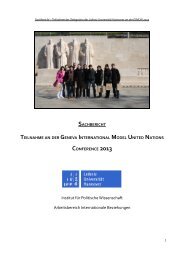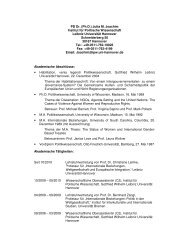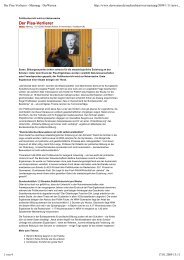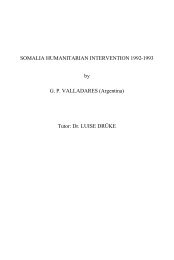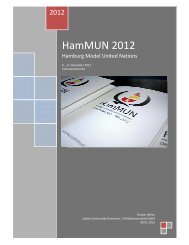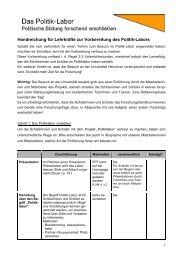Preventive Action for Refugee Producing Situations
Preventive Action for Refugee Producing Situations
Preventive Action for Refugee Producing Situations
You also want an ePaper? Increase the reach of your titles
YUMPU automatically turns print PDFs into web optimized ePapers that Google loves.
130 Chapter 3<br />
This program turned a major part of the population into refugees and displaced<br />
persons. By the end of the summer of 1962, the government of<br />
Vietnam claimed that 3,225 of the planned 11,316 hamlets had already been<br />
completed. Over 33 percent of the nation's total population were already<br />
living in completed hamlets. 296 According to a study by the Southeast Asia<br />
Program at Cornell University, by July 14, 1963, 8,737,613 people were<br />
housed in 7,202 hamlets. 297 Although this figure appears exaggerated, even<br />
U.S. Secretary of State Dean Rusk claimed that half the population had<br />
been relocated by 1963. 298<br />
According to the assessment of David Halberstam, the Pulitzer Prizewinning<br />
reporter of the The New York Times, the U.S. and Vietnamese<br />
authorities had hoped that the hamlet concept would <strong>for</strong>ce the Vietcong to<br />
attack the civilians, driving the enraged populace into the arms of the<br />
government. The policy, however, achieved exactly the opposite result:<br />
Most able-bodied men rallied to the Vietcong, perhaps less out of conviction than<br />
[in] defiance of the regime's coercive methods. 299<br />
Moreover, the Vietcong were not hungry, and did not need to prey off the<br />
villagers. Most of them were originally from the South, knew the area well,<br />
and thus easily infiltrated the hamlets.<br />
When they attacked, they attacked only the symbols of the Government: the<br />
armory or command post of the hamlet, the hamlet chief or the youth leaders. They<br />
rarely harmed the population, and so the people of the village, who saw that the<br />
Government had not kept its promises and could not protect them, often sided with<br />
the Vietcong after a raid. 300<br />
__________________________<br />
296 See Table, Government of Vietnam Report on Status of Strategic Hamlets in:<br />
Department of Defense, Study, Published by the Armed Forces Committee of<br />
the House of Representatives, O & D Task Force Final Report Bk. 3, United<br />
States -Vietnam Relations 1945-1967, IV. B. 2. Evolution of the War,<br />
Strategic Hamlet Program, 1961-1963, Appendix, p. 28.<br />
297 Milton Osborne, Strategic Hamlets in South Vietnam: A Survey and a<br />
Comparison, South East Asia Program (Ithaca, NY: Cornell 1965), p. 33.<br />
298 Noam Chomsky and Edward S. Herman, After the Cataclysm: Postwar<br />
Indochina and the Reconstruction of Imperial Ideology (Boston: South End<br />
Press, 1979), p. 322.<br />
299 Stanley Karnow, Vietnam, A History: The First Complete Account of Vietnam<br />
at War (New York: Penguin, 1984), p. 256.<br />
300 Melman,p.340.<br />
Analytical Discussion 131<br />
The results showed that the method of combating insurgency with a carrotand-stick<br />
approach (appealing programs and coercive control) utterly failed to<br />
bring the entire nation under the government's control, as Under Secretary of<br />
Sate George W. Ball commented. 301 It may well have been doomed from the<br />
outset because of "the peasants' resistance to measures which changed the<br />
pattern of rural life - whether aimed at security or control." 302 Such a policy of<br />
<strong>for</strong>ced relocation, dictated from above in absolute disregard of the interests<br />
and needs of the people, was bound to be both costly and ineffective and,<br />
even worse, to backfire on the initiators. Even the Pentagon itself<br />
acknowledged later that this program was doomed from the outset because it<br />
alienated many of those whose loyalty it aimed to win. 303<br />
On November 1,1963, a coup d'etat toppled the Diem regime; the deposed<br />
President and his brother Nhu, the architect of the strategic hamlet program,<br />
were killed. The strategic program died with them. 304<br />
Large-scale bombardment and military operation<br />
The skirmishes of the Vietnam War began escalating into major military<br />
operations following the Southeast Asia Resolution (later known as the<br />
Gulf of Tonkin Resolution), which was originally a contingency plan <strong>for</strong><br />
responding to potential attacks by the North Vietnamese Army <strong>for</strong>ces. 305 The<br />
incidents in the Gulf of Tonkin on August 2 and 4, 1964 in which the North<br />
Vietnamese Army allegedly attacked U.S. patrol ships, signaled the real<br />
beginning of the Vietnam War. Later, as the war became increasingly<br />
unpopular and its legitimacy was called more and more into question, the<br />
Gulf of Tonkin incident came under reexamination. An investigative hearing<br />
was held be<strong>for</strong>e the U.S. Senate Committee on For-<br />
_______________________<br />
301 The Pentagon Papers, Vol. u, The Senator Gravel Edition, Beacon Press<br />
Boston, 1971, p. 149.<br />
302 The Pentagon Papers, Vol. H, The Senator Gravel Edition, Beacon Press<br />
Boston, 1971, p. 131.<br />
303 The Pentagon Papers, Vol, n, The Senator Gravel Edition, Beacon Press<br />
Boston, 1971, p. 131.<br />
304 The Pentagon Papers, Published by the Armed Forces Committee of the House<br />
of Representatives, United States - Vietnam Relations 1945-1967, IV. B. 2.<br />
Evolution of the War, Strategic Hamlet Program, 1961-1963, p. 35.<br />
305 U.S. Senate, The Gulf of Tonkin: The 1964 Incidents; Hearing be<strong>for</strong>e the Committee<br />
on Foreign Relations. 93rd Congr., 21 February 1968 (Washington,D.C.: U.S.<br />
G.P.O.), pp. 11-12




